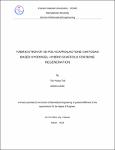| dc.description.abstract | In this thesis, a study was conducted on the fabrication of a hybrid scaffold by combining
polycaprolactone (PCL) scaffold and hydrogels based on chitosan (CS), hyaluronic acid (HA), and
hydroxyapatite (HAp). Specifically, CS is converted into N,O-carboxymethyl chitosan (NOCC),
and HA is oxidized to form aldehyde hyaluronic acid (AHA). HAp was added to a hydrogel to
improve osteoconductive properties. However, the hydrogel still has low mechanical strength,
making it unsuitable for cartilage or bone tissue regeneration. In this thesis, PCL scaffold was
created using particulate leaching and used as a three-dimension (3D) support matrix for hydrogel.
The process used a mixture of monosodium glutamate (M) and sucrose (S) in various weight ratios
(5M:5S, 7M:3S, 9M:1S) as porogens. The morphology, interconnectivity, and water resistance of
the PCL scaffolds were all investigated. These results show that PCL scaffolds with porogen ratios
of 7M:3S and 9M:1S have better interconnectivity than 5M:5S ratios. The hybrid scaffold (HS) is
then created by loading hydrogel into the PCL scaffold. Morphology, compressive strength, and
in vivo studies are also investigated in the HS samples. The compressive strength of the hybrid
scaffolds with a 9M:1S (51.478 ± 0.676 MPa) and 7M:3S (56.163 ± 0.607 MPa) ratios are similar
to cancellous bone. Through resazurin assay using L929 fibroblast cells, all hybrid scaffolds are
biocompatible. In vivo tests were carried out on mouse and rabbit models. The mice received a
calvarial defect, while the rabbits received a tibial defect. To compare the wound healing abilities
of hybrid scaffolds and pure hydrogel, they were implanted into the defect area. The bone tissues
at the defect site are then harvested and stained for histology with hematoxylin and eosin. The
results suggest that the hybrid scaffolds with porogens ratio of 7M:3S have the potential to promote
bone healing. | en_US |


